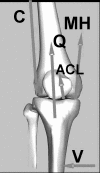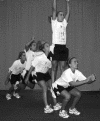Rationale and Clinical Techniques for Anterior Cruciate Ligament Injury Prevention Among Female Athletes
- PMID: 15592608
- PMCID: PMC535528
Rationale and Clinical Techniques for Anterior Cruciate Ligament Injury Prevention Among Female Athletes
Abstract
OBJECTIVE: To present the rationale and detailed techniques for the application of exercises targeted to prevent anterior cruciate ligament (ACL) injury in high-risk female athletes. BACKGROUND: Female athletes have a 4- to 6-fold increased risk for ACL injury compared with their male counterparts playing at similar levels in the same sports. The increased ACL injury risk coupled with greater sports participation by young women over the last 30 years (9-fold increase in high school and 5-fold increase in collegiate sports) has generated public awareness and fueled several sex-related mechanistic and interventional investigations. These investigations provide the groundwork for the development of neuromuscular training aimed at targeting identified neuromuscular imbalances to decrease ACL injury risk. DESCRIPTION: After the onset of puberty, female athletes may not have a neuromuscular spurt to match their similar, rapid increase in growth and development. The lack of a natural neuromuscular adaptation may facilitate the development of neuromuscular imbalances that increase the risk for ACL injury. Dynamic neuromuscular analysis training provides the methodologic approach for identifying high-risk individuals and the basis of using interventions targeted to their specific needs. CLINICAL ADVANTAGES: Dynamic neuromuscular training applied to the high-risk population may decrease ACL injury risk and help more female athletes enjoy the benefits of sports participation without the long-term disabilities associated with injury.
Figures












References
-
- Frank CB, Jackson DW. The science of reconstruction of the anterior cruciate ligament. J Bone Joint Surg Am. 1997;79:1556–1576. - PubMed
-
- Fleming BC. Biomechanics of the anterior cruciate ligament. J Orthop Sports Phys Ther. 2003;33:A13–A15. - PubMed
-
- Arendt E, Dick R. Knee injury patterns among men and women in collegiate basketball and soccer: NCAA data and review of literature. Am J Sports Med. 1995;23:694–701. - PubMed
-
- Malone TR, Hardaker WT, Garrett WE, Feagin JA, Bassett FH. Relationship of gender to anterior cruciate ligament injuries in intercollegiate basketball players. J South Orthop Assoc. 1993;2:36–39.
-
- National Federation of State High School Associations. Indianapolis, IN: National Federation of State High School Associations; 2002. 2002 High School Participation Survey.
Grants and funding
LinkOut - more resources
Full Text Sources
Other Literature Sources
